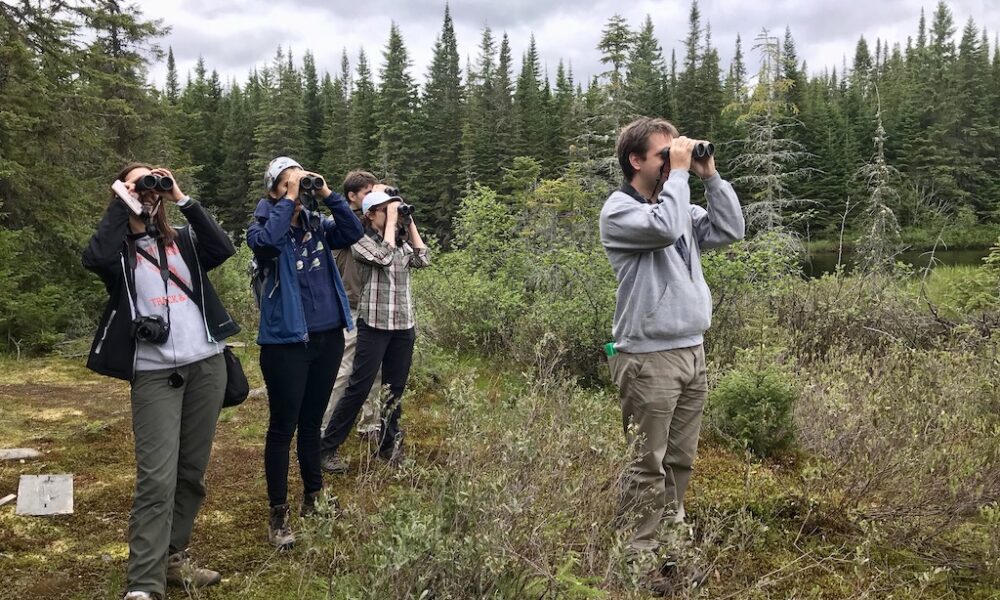The founders of the McGill Students’ Birding Club (MSBC) met six years ago while taking WILD 420, an ornithology course at McGill. Since the club’s creation, birders of the McGill community have had a place to congregate and share their love for our feathered friends.
On the club’s Facebook group, members share photos and videos of their sightings as well as news on conservation threats to local bird habitats. Members sometimes request the community’s help in identifying a certain species spotted outside their window or a specific high-pitched call heard on a hike. A few months ago, one member posted an audio recording of bird sounds they recorded on Mont-Royal and said they planned to use it in composing a piece for the McGill Symphony Orchestra.
One aspect that unites those who flock to the bird-watching community is a curiosity for the environment, explained Anthony Zerafa, M.Sc.’22 and one of the club’s four founders.
“I’ve always had a deep fascination in the natural world, not just birds,” Zerafa said. “[Bird watchers] are interested in the world around them and want to learn more.”
With such an appreciation for the wild, many bird watchers are either already involved in environment conservation efforts or have become involved through birding.
“When you start to appreciate and learn about the wildlife that can be found around you, you then want to ensure that that wildlife is protected,” Zerafa said. “You want the place you like to go birdwatching, where you may have had many fond memories, to continue to be a good habitat for the birds.”
After an excursion, birders will often post about their experiences and list the species they spot, taking care to note rarities. Though a successful birding trip requires patience, quiet, and more observance than action, the excitement lies in the accumulation of experience and knowledge.
“It really can be overwhelming at times when you first start out, but once you start to get a sense of the different birds that are in the environment and what you can see at different times of years, it quickly becomes addictive,” Zerafa said. “It’s very much like Pokemon Go, but in real life.”
Even as someone with no birding experience, I was reeled in by the passion and flair with which the bird watchers recounted their sightings. As each encounter is unpredictable, the accounts can resemble action adventures, keeping both the birder and reader hooked.
“Guess it’s time to head home,” one member wrote in a post shared to the Facebook page. “But no! The surprise: A ring-necked pheasant saunters out of the nearest shrubbery, to hang with his buddies the Fox sparrows. Much celebratory dancing.”
In the U.K., birding’s allure is only sometimes a relaxing pastime—other times, it is channeled into aggressive fervor. British twitching, extreme competitive birdwatching, leads to fierce rivalries, “twitcher madness,” and even tricks of sabotage.
However, for McGill’s community of bird watchers—and for most elsewhere—the hobby remains rooted in a communal appreciation of the vast number of species waiting to be admired.
“I mean, who cares in reality, if you’ve seen the most birds,” Zerafa said. “It’s mostly just personal competition, trying to challenge yourself to see as many species as possible.”
Prior to the pandemic, the club hosted weekly bird watching outings and annual day trips to farther birding locations, including Amherst Island in Kingston, Ontario or Victoriaville, a two-hour drive from Montreal. They hope to resume excursions in the upcoming weeks.
Beginner’s Guide to Birding in Montreal
Locations
Montreal Botanical Garden: The Garden’s diverse mix of habitats attract a large variety of species and is free to visit during the winter months.
Mont Royal Cemetery: The Cemetery’s many fruit trees make it a prime spot for bird watchers.
Morgan Arboretum at MacDonald Campus: The Arboretum has one of the highest numbers of breeding species on the island.
Tools
Binoculars: Scan for movement, then train your binoculars when you believe you have spotted a bird.
Mentor: In order to identify a bird from sight, sometimes only sound, prior knowledge is needed. Zerafa recommends joining others’ excursions or having an experienced mentor provide guidance.
Merlin Bird ID App: A popular app among bird watchers, Merlin helps identify bird species through visual cues and sound.








